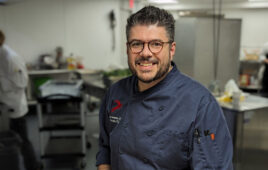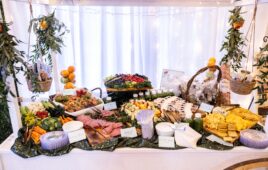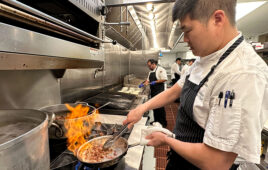
Brian Sorin, Sous Chef, Austin CC
Any good chef knows that banquet production often feels like a race to the finish line. Ensuring that all ingredients are sourced and prepped, dishes are well-prepared and presented, and that service rolls out at a steady clip is a process that requires a deft hand—and the ability to adjust as needed. Here’s how those who have been in the trenches are pulling off a masterful plate-up, from start to finish.
Step-by-Step Prep
Brian Sorin, Sous Chef at Austin (Minn.) Country Club is a big believer in advance planning and has his own strategies when it comes to banquet preparation.
“Sometimes, [menu] tastings can be months before the actual event,” he says. “Having notes and [taking] pictures will help you remember what you made and what it looked like.”
Before having his notebook and camera at the ready, Sorin spent fifteen years at a local Hyatt where he divided his time between banquets and a la carte dining. In the last two and one-half years at Austin Country Club, he has served as sous chef, perfecting his craft for special events and other catered affairs. Working steady banquet gigs has enabled Sorin to finetune his processes and zero in on specific factors.
“Some of the things I consider when it come to plating are whether something can be replicated multiple times, ease of assembly, making sure that the plates have a variety of color and the amount of time it takes to make each component of the menu,” he notes.

When it’s time to start plating, Brian Sorin, Sous Chef at Austin CC, opts for a traditional assembly line, assigning one component per person.
Ensuring quality and consistency for banquet plate-ups is no small feat, but Sorin has figured out how to make it work. He relies on standardized recipes when possible and makes sure all his ingredients are counted and weighed out as the recipe dictates. And if Sorin is able to assign the same crew—staff size permitting—to make sauces, he is assured a smooth repertoire for a variety of dishes.
Speaking of his banquet crew, Sorin is steadfast about going over his game plan with everyone, so that they are aware of each other’s responsibilities. He likes to create checklists with firing times, portion totals and per pan portion figures. And when it’s time to start plating, Sorin opts for a traditional assembly line, assigning one component per person. “You want to have your fastest person at the start to set the pace and the most detail-oriented person at the end to make sure all the plates look the same,” he advises.
While it may appear that Sorin has perfected the art of plate-up, he has experienced some minor mishaps. A kitchen fire during his Hyatt days left him without a banquet kitchen for nearly two months.
“We were lucky enough to find a local catering business that let us use their kitchen space, so we had a place to cook,” he recalls. “But everything had to be cooked there and brought back to the hotel hot and plated in the meeting rooms, back hallways or wherever we could set up some tables and warmer boxes.” As if that wasn’t difficult enough, Sorin and his team had to contend with a power outage a couple of hours before plate-up, which meant no gas or exhaust hoods. “Dessert and salad were plated in the walk-in cooler, and we were able to get a portable propane oven delivered so we could cook outside,” he adds. Learning from these moments has been invaluable.

While her kitchen lacks a designated banquet crew, Stephanie Wilson, Executive Chef at Jackson Hole Golf & Tennis, uses the same staff for every event, whenever possible, for guaranteed consistency and is involved in all aspects of prepping and plating.
A (Jackson) Hole in One
For Stephanie Wilson, Executive Chef at Jackson Hole Golf & Tennis Jackson Hole, Wy., many hands do indeed make light work. With the banquet space located in an event tent—outside the main dining facility—she and her staff must ensure timely executions on a regular basis, while keeping pace with a steady diet of headlining dishes. Wilson prides herself on designing banquet menus that have something for everyone. “We try to offer all the major options to meet the wants and dietary needs of our guests, while creating a high volume of product that looks beautiful and tastes delicious,” she says.

grilled beef tenderloin with scalloped potatoes, grilled asparagus, red wine demi glace and crispy leeks
Banquet menu selections must meet the key factors—color, texture, contrast and height—for ensuring a memorable dish. Among the more popular featured items are a grilled beef tenderloin with scalloped potatoes, grilled asparagus, red wine demi glace and crispy leeks (“It’s steak and potato, which you can’t go wrong with in Wyoming”), as well as a vegan risotto with blistered tomatoes, local roasted oyster mushrooms and baby kale chips with a parsley oil.
The extra sets of hands that allow for polished plate-ups are something that Wilson has come to rely on over the past three and one-half years at JH Golf & Tennis. While having limited prior banquet and catering experience, she had the good fortune of working alongside a sous chef who taught her the ropes. “Working with her allowed me to gain insight into best practices and what really works well for our guests and property,” she notes.
While her kitchen lacks a designated banquet crew, Wilson uses the same staff for every event, whenever possible, for guaranteed consistency and is involved in all aspects of prepping and plating.
“I have been lucky enough to have a lead cook that has been returning seasonally for a couple of years that knows exactly how I want things done and how they should taste,” she adds. Each plate goes through multiple checkpoints before leaving the kitchen: cooks who plate up; Wilson who sauces and garnishes; the F&B manager who expedites, wipes and loads plates; and the servers who she likens to her last line of defense. “Sometimes, they will catch a wipe that we missed or send us back a rack of lamb that is a little too wobbly to walk to the table,” she says.
Even with a seemingly foolproof prep, Wilson and her crew must wrestle with timing. The event space’s distance from the kitchen requires constant time checks to ensure that prepared dishes are ready to go when needed. Abiding by local noise regulations means early service times; a typical 4 p.m. ceremony means 5:15 p.m. salads and bread drops and 5:45-6 p.m. entree service.
“Little details, like making sure we aren’t producing noise during the ceremony, means we need to have all of our appetizers (hot or cold) and salad mis en place ready and at the tent by no later than 3:45,” she explains. Main dishes are finished in the clubhouse kitchen and then transported via hot holding containers to the tent for a later plate-up.

Fine-tuning banquet plate-up has resulted in what Wilson calls her best year yet in terms of efficiency. Instead of having one cook tasked with multiple dishes, the process has transitioned to one cook on each dish for plating. This rejiggered process still involves multiple parties, but Wilson believes the extra steps are worth it. “They [the plates] are handled a lot, but I feel that this ensures the most eyes on things and helps avoid errors,” she affirms.
Smooth processes aside, Wilson has encountered plate-up-related challenges along the way. Of note are clients that opt for entrée selections, but not for a seating chart.
“Even though it’s a real headache, we always end up making it work,” she says. “We will have a server or two make rounds with a pen and paper to handwrite a seating chart while guests are busy eating salads.”
Another instance involves clients who choose to use their own decorative plates, but only order the exact number for their guest count.
“Without extra plates, we are making a mad dash back up to the restaurant in between courses,” she says. “It’s more of a pain than anything, but we want to ensure dishes are going out on beautiful, sanitized plates.”




